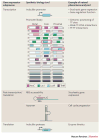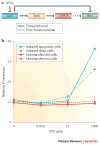Synthetic biology: understanding biological design from synthetic circuits
- PMID: 19898500
- PMCID: PMC3138802
- DOI: 10.1038/nrg2697
Synthetic biology: understanding biological design from synthetic circuits
Abstract
An important aim of synthetic biology is to uncover the design principles of natural biological systems through the rational design of gene and protein circuits. Here, we highlight how the process of engineering biological systems - from synthetic promoters to the control of cell-cell interactions - has contributed to our understanding of how endogenous systems are put together and function. Synthetic biological devices allow us to grasp intuitively the ranges of behaviour generated by simple biological circuits, such as linear cascades and interlocking feedback loops, as well as to exert control over natural processes, such as gene expression and population dynamics.
Figures



References
-
- Mattick JS. RNA regulation: a new genetics? Nat Rev Genet. 2004;5:316–323. - PubMed
-
- Davidson EA. The regulatory genome: gene regulatory networks in development and evolution. Academic Press; 2006.
-
- Bridgham JT, Carroll SM, Thornton JW. Evolution of hormone-receptor complexity by molecular exploitation. Science. 2006;312:97–101. Uses rational synthesis of a resurrected glucocorticoid receptor to explore the evolution of the receptor ligand–pair. - PubMed
-
- Rapp M, Seppala S, Granseth E, von Heijne G. Emulating membrane protein evolution by rational design. Science. 2007;315:1282–1284. - PubMed
Publication types
MeSH terms
Grants and funding
LinkOut - more resources
Full Text Sources
Other Literature Sources

